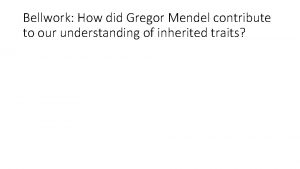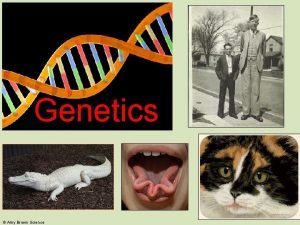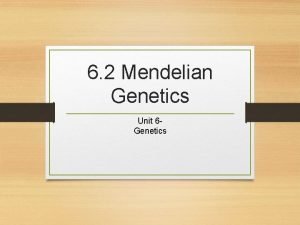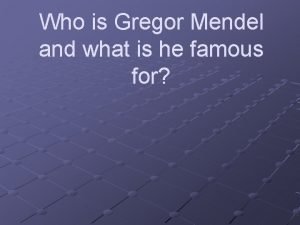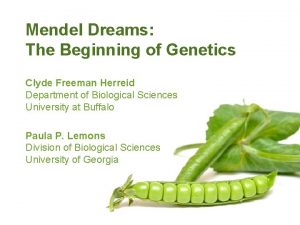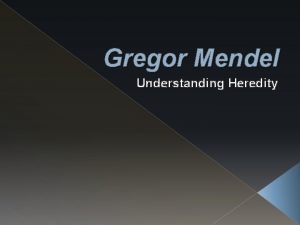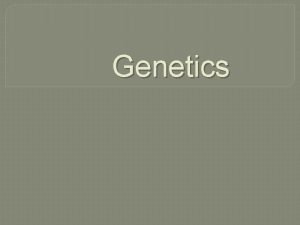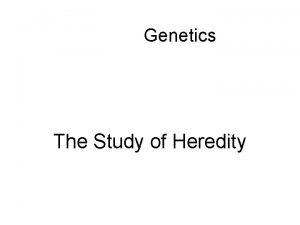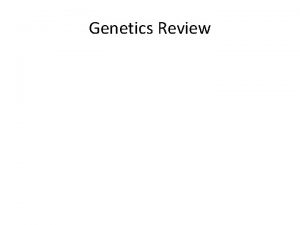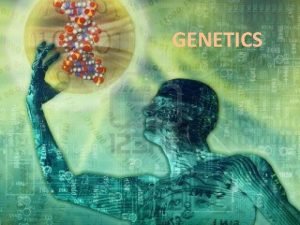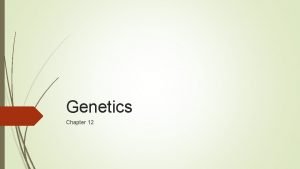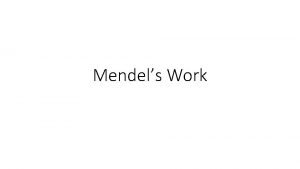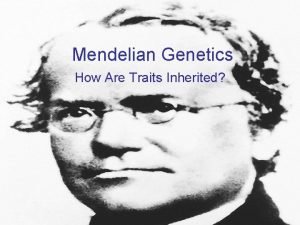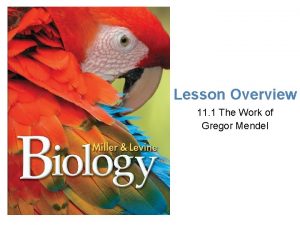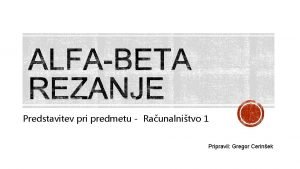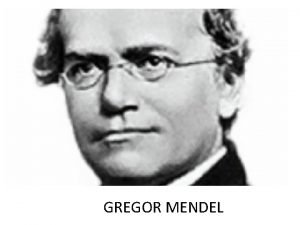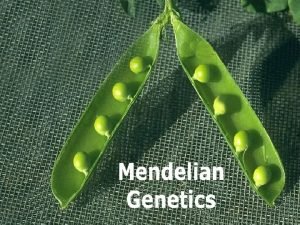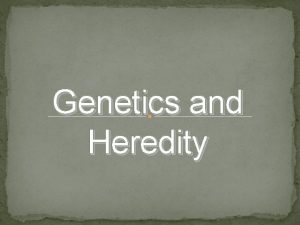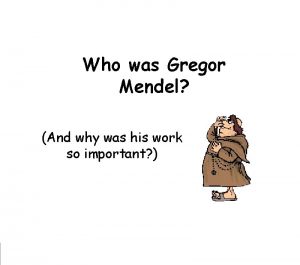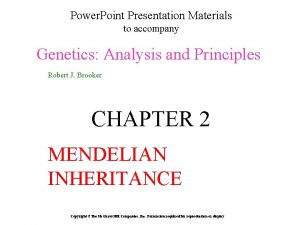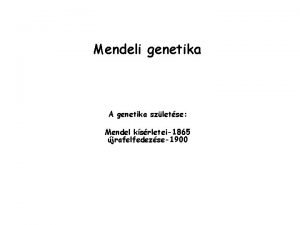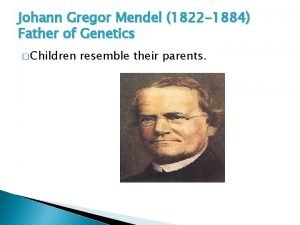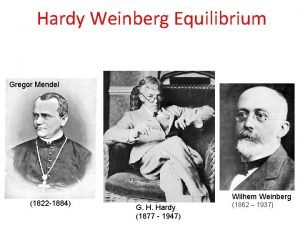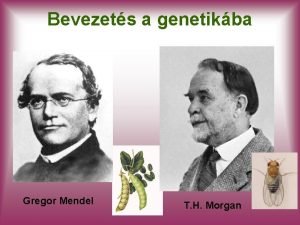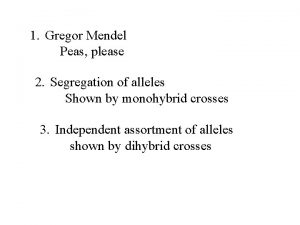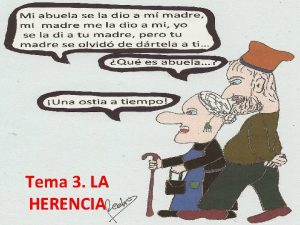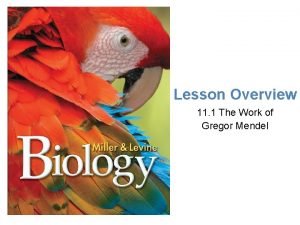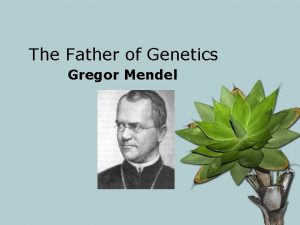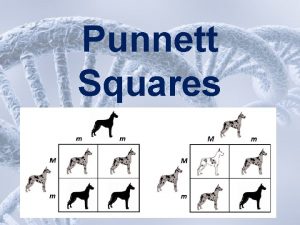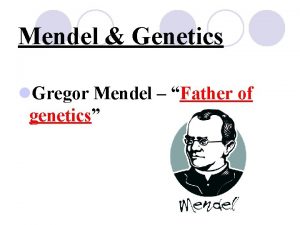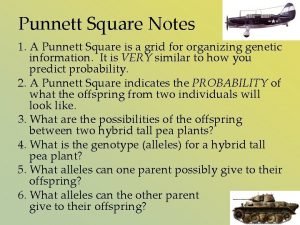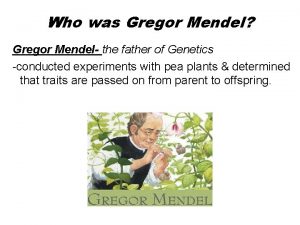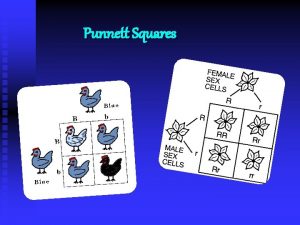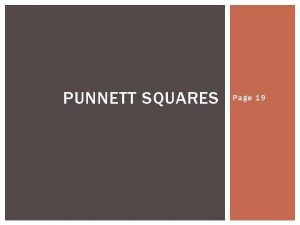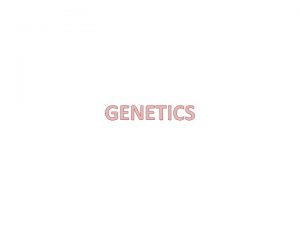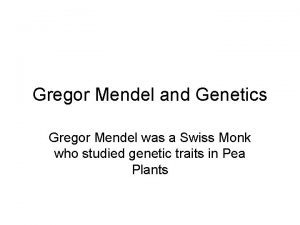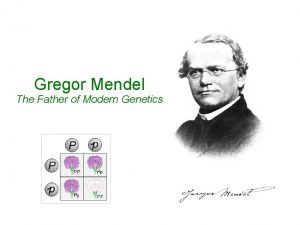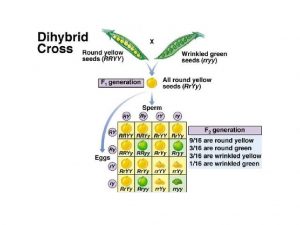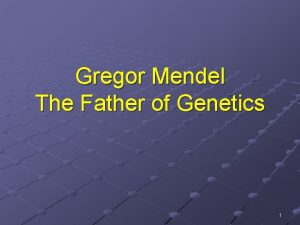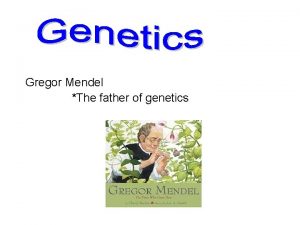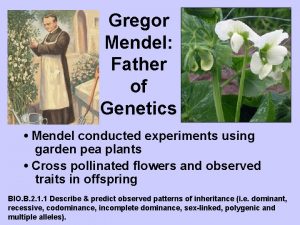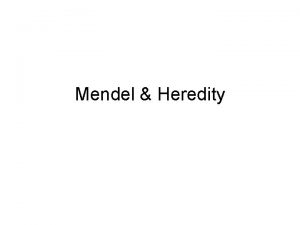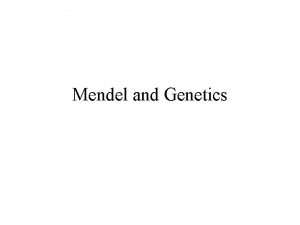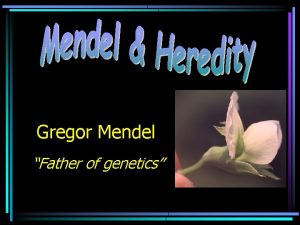Punnett Square Notes Gregor Mendel Father of Genetics










































- Slides: 42

Punnett Square Notes

Gregor Mendel Father of Genetics 1 st important studies of heredity Identified specific traits in the garden pea and studied them from one generation to another

Mendel’s Conclusions 1. Law of Segregation – Two alleles for each trait separate when gametes form; Parents pass only one allele for each trait to each offspring 2. Law of Independent Assortment – Genes for different traits are inherited independently of each other

What is Genetics? Genetics is the scientific study of heredity

What is a Trait? A trait is a specific characteristic that varies from one individual to another. Examples: Brown hair, blue eyes, tall, curly

What is an Allele? Alleles are the different possibilities for a given trait. Every trait has at least two alleles (one from the mother and one from the father) Example: Eye color – Brown, blue, green, hazel Examples of Alleles: B = Brown Eyes b = Blue Eyes G = Green Eyes g = Hazel Eyes

What are Genes? Genes are the sequence of DNA that codes for a protein and thus determines a trait.

Dominant vs. Recessive Dominant - Masks the other trait; the trait that shows if present Represented by a capital letter R Recessive – An organism with a recessive allele for a particular trait will only exhibit that trait when the dominant allele is not present; Will only show if both alleles are present Represented by a lower case letter r

Incomplete Dominance - Situation in which one allele is not completely dominant over another. Example – Red and white flowers are crossed and pink flowers are produced.

Codominance - Situation in which both alleles of a gene contribute to the phenotype of the organism. Example – A solid white cow is crossed with a solid brown cow and the resulting offspring are spotted brown and white (called roan). +

Dominant & Recessive Practice Upper case letters represent Dominant traits. Lower case letters represent Recessive traits. TT - Represent offspring with straight hair Tt - Represent offspring with straight hair tt - Represents offspring with curly hair T – straight hair t - curly hair

Homozygous vs. Heterozygous Homozygous – Term used to refer to an organism that has two identical alleles for a particular trait (TT or tt) Heterozygous - Term used to refer to an organism that has two different alleles for the same trait (Tt) RR rr Rr

Genotype vs. Phenotype Genotype – The genetic makeup of an organism; The gene (or allele) combination an organism has. Example: Tt, ss, GG, Ww Phenotype – The physical characteristics of an organism; The way an organism looks Example: Curly hair, straight hair, blue eyes, tall, green

Punnett Squares Punnett Square – Diagram showing the gene combinations that might result from a genetic cross Used to calculate the probability of inheriting a particular trait Probability – The chance that a given event will occur


Punnett Square Parent Offspring

How to Complete a Punnett Square

Y-Yellow y-white Genotype: 1: 2: 1 (YY: Yy: yy) Phenotype: 3 Yellow 1 White

Let’s put a couple examples in our notebook!

You Try It Now! Complete the following punnett square problems in your SISN. Create a punnett square and give the genotype and phenotype for the following cross: TT x tt (T = Tall and t = Short)

TT x tt Step One: Set Up Punnett Square (put one parent on the top and the other along the side) t T T

TT x tt Step Two: Complete the Punnett Square T t Tt Tt

TT x tt Step Three: Write the genotype and phenotype T t Tt Tt Remember: Each box is 25% Genotype: 4 - Tt Phenotype: 100% Tall

You Try It. Complete the following punnett square problems in your SISN. Give the genotype and phenotype for the following cross: Tt x tt

Tt x tt Step One: Set Up Punnett Square (put one parent on the top and the other along the side) t t T t

Tt x tt Step Two: Complete the Punnett Square T t Tt tt

Tt x tt Step Two: Complete the Punnett Square T t Tt tt Remember: Each box is 25% Genotype: Tt - 2 (50%) tt - 2 (50%) Phenotype: 50% Tall 50% Short

Work through the practice!!!

Punnett Square Pop Quiz Take out a blank sheet of notebook paper and something to write with.

1. What is the dominant gene? What is the recessive gene? B – Brown eyes b – Blue Eyes

2. Label which is heterozygous and which is homozygous. a. BB b. Bb c. bb

3. A scientist crossed a homozygous tall daisy with a homozygous short daisy. Each of the daisies has two of the same alleles that make them homozygous. The tall trait of the daisy is the dominant, and is represented with a “D”. The short trait of the daisy is the recessive trait, and is represented with a “d”. Use a Punnett Square to cross a homozygous tall daisy (DD) with a homozygous short daisy (dd).

4. In the first question, what is the genotype and phenotype of all the 1 st generation offspring? Genotype ________ Phenotype ________

5. Black fur (B) in guinea pigs is dominant over white fur (b). Create a punnett square that displays the offspring if a heterozygous black fur guinea pig is crossed with a homozygous white fur guinea pig.

Multiple Alleles Multiple Alleles- Three or more alleles of the same gene. Even though three or more alleles exist for a particular trait, an individual can only have two alleles - one from the mother and one from the father.

Examples of Multiple Alleles 1. Coat color in rabbits is determined by a single gene that has at least four different alleles. Different combinations of alleles result in the four colors you see here.

Examples of Multiple Alleles Blood Type – 3 alleles exist (IA, IB, and io), which results in four different possible blood types What are the four main blood types? Hair Color – Too many alleles exist to count There are over 20 different shades of hair color.

Blood type punnett squares

Blood Type Punnett Square A man who is AB marries a woman who is heterozygous type B. If they had four children, what would their probable genotypes and phenotypes be? *hint – you will need to create a punnett square.


Multiple Alleles There Always Multiple Alleles! Genetic inheritance is often presented with straightforward examples involving only two alleles with clear-cut dominance. This makes inheritance patterns easy to see. But very few traits actually only have two alleles with clear-cut dominance. As we learn more about genetics, we have found that there are often hundreds of alleles for any particular gene. We probably know this already - as we look around at other people, we see infinite variation.

Blood type
 Gregor mendel a monk
Gregor mendel a monk 11-2 probability and punnett squares answer key
11-2 probability and punnett squares answer key Chapter 11 biology review answers
Chapter 11 biology review answers How did gregor mendel contribute to genetics
How did gregor mendel contribute to genetics Gametes punnett square
Gametes punnett square Mendel was a
Mendel was a Who is gregor mendel and what is he famous for
Who is gregor mendel and what is he famous for Section 11–1 the work of gregor mendel
Section 11–1 the work of gregor mendel Who is gregor mendel
Who is gregor mendel Rryy x rryy
Rryy x rryy Gregor mendel chart
Gregor mendel chart Chapter 12 lesson 1 the work of gregor mendel
Chapter 12 lesson 1 the work of gregor mendel Who is gregor mendel
Who is gregor mendel What did gregor mendel research
What did gregor mendel research What did gregor mendel research
What did gregor mendel research How many pairs of chromosomes
How many pairs of chromosomes Conclusion gregor mendel
Conclusion gregor mendel Chapter 12 lesson 1 the work of gregor mendel
Chapter 12 lesson 1 the work of gregor mendel Gregor mendels work
Gregor mendels work Gregor mendel laws
Gregor mendel laws Gregor mendel summary
Gregor mendel summary Wo ist bach geboren
Wo ist bach geboren Mendel's law of independent assortment
Mendel's law of independent assortment Who is gregor mendel and what did he do?
Who is gregor mendel and what did he do? Gregor mendel referat
Gregor mendel referat Gregor mendel
Gregor mendel Austrian monk
Austrian monk Gregor mendel video
Gregor mendel video Gregor mendel laws
Gregor mendel laws Gregor mendel laws
Gregor mendel laws Tesztelő keresztezés
Tesztelő keresztezés Gregor mendel 1865
Gregor mendel 1865 Gregor mendel
Gregor mendel Hardy weinberg equilibrium
Hardy weinberg equilibrium Gregor mendel austrian monk
Gregor mendel austrian monk Gregor mendel
Gregor mendel Mendel genetics
Mendel genetics Fr gregor mendel
Fr gregor mendel Gregor mendel
Gregor mendel Alelo
Alelo Gregor mendel
Gregor mendel Gregor johann mendel
Gregor johann mendel Gregor mendel
Gregor mendel



